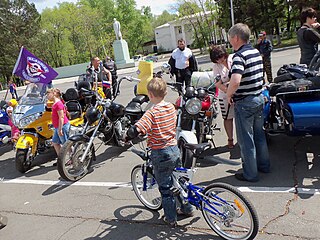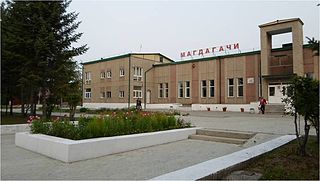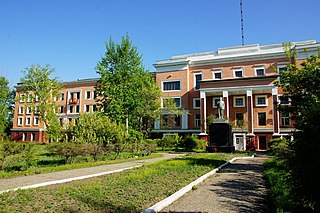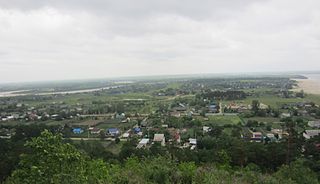
Tynda is a town in Amur Oblast, Russia, located 568 kilometers (353 mi) northwest of Blagoveshchensk. It is an important railway junction, informally referred to as the capital of the Baikal-Amur Mainline. Its population has declined sharply in recent years: 36,275 (2010 Census); 40,094 (2002 Census); 61,996 (1989 Soviet census).

Raychikhinsk is a town in Amur Oblast, Russia, located in the Zeya–Bureya basin, about 40 kilometers (25 mi) from the Amur River and the border with China, and about 165 kilometers (103 mi) east of Blagoveshchensk, the administrative center of the oblast. Population: 20,534 (2010 Census); 24,498 (2002 Census); 27,873 (1989 Soviet census).

Shimanovsk is a town in Amur Oblast, Russia, located on the Bolshaya Pyora River, 250 kilometers (160 mi) northwest of Blagoveshchensk. Population: 19,815 (2010 Census); 22,267 (2002 Census); 26,274 (1989 Soviet census).

Magdagachi is an urban locality and the administrative center of Magdagachinsky District of Amur Oblast, Russia, located 367 kilometers (228 mi) northwest of Blagoveshchensk. Population: 10,897 (2010 Census); 12,208 (2002 Census); 15,578 (1989 Soviet census).

Svobodny is a town in Amur Oblast, Russia, located on the right bank of the Zeya River, 167 kilometers (104 mi) north of Blagoveshchensk, the administrative center of the oblast. Population: 58,778 (2010 Census); 63,889 ; 80,006 (1989 Soviet census).

Skovorodino is a town and the administrative center of Skovorodinsky District of Amur Oblast, Russia, located in the upper stream of the Bolshoy Never River 669 kilometers (416 mi) northwest of Blagoveshchensk, the administrative center of the oblast. Skovorodino is located 54 kilometers (34 mi) from the border with Heilongjiang, China. Population: 9,564 (2010 Census); 10,566 (2002 Census); 13,824 (1989 Soviet census).
Progress is an urban locality in Amur Oblast, Russia, located southeast of Blagoveshchensk, the administrative center of the oblast. Population: 11,156 (2010 Census); 13,080 (2002 Census); 14,345 (1989 Soviet census).

Blagoveshchensky District is an administrative and municipal district (raion), one of the twenty in Amur Oblast, Russia. The area of the district is 3,060 square kilometers (1,180 sq mi). Its administrative center is the city of Blagoveshchensk. Population: 19,641 (2010 Census); 18,673 ; 18,192 (1989 Soviet census).

Shimanovsky District is an administrative and municipal district (raion), one of the twenty in Amur Oblast, Russia. The area of the district is 14,554 square kilometers (5,619 sq mi). Its administrative center is the town of Shimanovsk. Population: 5,956 (2010 Census); 7,275 ; 8,588 (1989 Soviet census).

Skovorodinsky District is an administrative and municipal district (raion), one of the twenty in Amur Oblast, Russia. The area of the district is 20,509 square kilometers (7,919 sq mi). Its administrative center is the town of Skovorodino. Population: 29,558 (2010 Census); 34,269 ; 42,998 (1989 Soviet census). The population of Skovorodino accounts for 32.4% of the district's total population.

Svobodnensky District is an administrative and municipal district (raion), one of the twenty in Amur Oblast, Russia. The area of the district is 7,318 square kilometers (2,825 sq mi). Its administrative center is the town of Svobodny. Population: 14,315 (2010 Census); 14,568 ; 16,879 (1989 Soviet census).

Tyndinsky District is an administrative and municipal district (raion), one of the twenty in Amur Oblast, Russia. The area of the district is 83,258 square kilometers (32,146 sq mi). Its administrative center is the town of Tynda. Population: 16,065 (2010 Census); 16,701 ; 35,067 (1989 Soviet census).

Zavitinsky District is an administrative and municipal district (raion), one of the twenty in Amur Oblast, Russia. The area of the district is 3,286 square kilometers (1,269 sq mi). Its administrative center is the town of Zavitinsk. Population: 15,970 (2010 Census); 20,198 ; 29,637 (1989 Soviet census). The population of Zavitinsk accounts for 71.9% of the district's total population.

Zeysky District is an administrative and municipal district (raion), one of the twenty in Amur Oblast, Russia. The area of the district is 87,486 square kilometers (33,779 sq mi). Its administrative center is the town of Zeya. Population: 16,847 (2010 Census); 20,827 ; 42,298 (1989 Soviet census).

Zeya is a town in Amur Oblast, Russia, located on the Zeya River 230 kilometers (140 mi) southeast of Tynda and 532 kilometers (331 mi) north of Blagoveshchensk.
Novobureysky is an urban locality and the administrative center of Bureysky District of Amur Oblast, Russia. Population: 8,344 (2010 Census); 8,892 (2002 Census); 8,988 (1989 Soviet census).
Seryshevo is an urban locality and the administrative center of Seryshevsky District of Amur Oblast, Russia. Population: 10,816 (2010 Census); 12,186 (2002 Census); 13,456 (1989 Soviet census).
Ivanovka is a rural locality and the administrative center of Ivanovsky District of Amur Oblast, Russia. Population: 6,617 (2010 Census); 6,785 (2002 Census); 7,068 (1989 Soviet census).
Talakan is an urban locality in Bureysky District of Amur Oblast, Russia. Population: 5,176 (2010 Census); 6,545 (2002 Census); 4,479 (1989 Soviet census).
Ushumun is an urban locality in Magdagachinsky District of Amur Oblast, Russia. Population: 2,390 (2010 Census); 2,920 (2002 Census); 3,232 (1989 Soviet census).
























